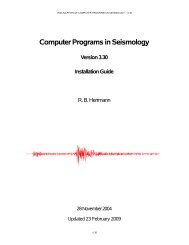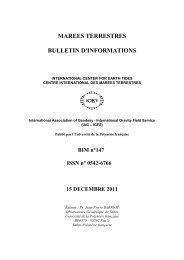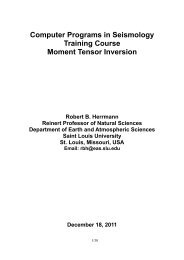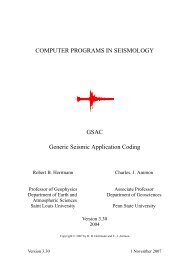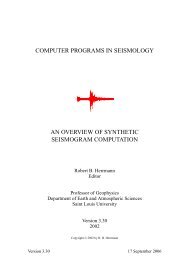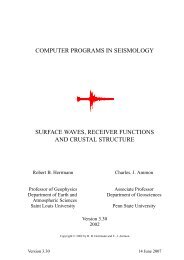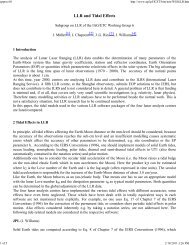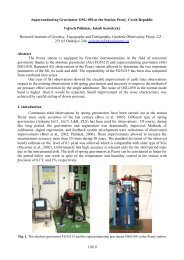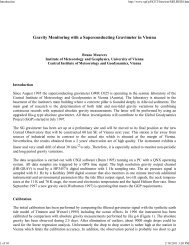3.04 Gravimetric Methods – Superconducting Gravity Meters
3.04 Gravimetric Methods – Superconducting Gravity Meters
3.04 Gravimetric Methods – Superconducting Gravity Meters
You also want an ePaper? Increase the reach of your titles
YUMPU automatically turns print PDFs into web optimized ePapers that Google loves.
96 <strong>Superconducting</strong> <strong>Gravity</strong> <strong>Meters</strong><br />
compact SG, in this case the C012 at Membach. The<br />
electronic step was applied to various combinations<br />
of filter type and time intervals (1<strong>–</strong>4 min), and the<br />
output was Fourier-analyzed to determine the amplitude<br />
and phase response. The time lag results showed<br />
an accuracy of 0.003 s for the GGP1 filter and<br />
0.075 s for the raw gravity signal output. The sine<br />
wave method gave very similar results, confirming<br />
the integrity of the method. The amplitude gain of<br />
the electronics system was determined to be flat<br />
from 500 to 2000 s, the longest period determined<br />
by either method. Further details are given on the<br />
GGP website.<br />
<strong>3.04</strong>.2.5 Other Corrections to Residual<br />
<strong>Gravity</strong><br />
<strong>3.04</strong>.2.5.1 Polar motion<br />
One important signal contained in an SG record is<br />
the 14 month (435 day) oscillation of the rotation<br />
pole, or Chandler wobble. As noted previously,<br />
Richter’s (1983) first observation of this signal, with<br />
only 5 mGal amplitude, was a turning point in the<br />
refinement of gravity residuals. Since then, every SG<br />
station has recorded data that when suitably processed<br />
show the polar motion (e.g., Harnisch and<br />
Harnisch, 2006a). Naturally, some records are very<br />
clear and others not so clear, depending on the epoch<br />
(amplitude of the motion) and the quality of the<br />
instrument and site.<br />
With most data sets, it is not difficult to see the<br />
polar motion once tides and atmospheric pressure are<br />
subtracted. Indeed, for the most part, the highly<br />
accurate space geodetic series for the polar orientation<br />
that is given on the IERS website can be used<br />
directly at any of the gravity stations. A simple conversion<br />
is usually made between the (x, y) amplitudes<br />
of polar motion (m 1 , m 2 ) in radians and the gravity<br />
effect g in mGal (e.g., Wahr, 1985):<br />
g ¼ 3:90 10 9 sin 2 ½cosðm 1 Þ sinðm 2 ÞŠ ½6Š<br />
where (,) are station latitude and longitude. The<br />
numerical factor includes the nominal value of 1.16<br />
for the gravimetric delta factor, whereas fitted solutions<br />
are usually closer to ¼ 1.18 (e.g., Loyer et al.,<br />
1999; Harnisch and Harnisch, 2006b). In many studies,<br />
the polar motion is considered as a quantity very<br />
accurately determined from space geodetic data, but<br />
it is interesting to observe its signature in either an<br />
individual or collective gravity series.<br />
<strong>3.04</strong>.2.5.2 Instrument drift<br />
From a historical viewpoint, particularly for spatial<br />
gravity surveys, the term ‘drift’ has been applied to<br />
almost any unwanted time-varying gravity signal.<br />
This usage persists in the SG literature and sometimes<br />
causes confusion. Here we use drift as an<br />
instrument characteristic, because all other gravity<br />
variations have specific causes.<br />
From an instrumental point of view (e.g.,<br />
Goodkind, 1999), drift is likely to be either a linear<br />
or exponential function of time, but its size is not easy<br />
to predict. The exponential behavior can be reset<br />
after a loss of levitation or other magnetic changes<br />
within the sensor. Under normal operation, the user<br />
can generally assume that drift will level off after<br />
installation and gradually become more linear as<br />
time progresses. Representative values of instrument<br />
drift are frequently less than 4 mGal yr 1 where these<br />
have been checked carefully with AGs (see above).<br />
From a processing point of view, other functions<br />
such as polynomials have been used as a model for<br />
instrument drift but there is no physical reason to<br />
prefer such a choice. We recommend that an exponential<br />
drift be assumed from some initialization<br />
event for the instrument and later this may be<br />
replaced with a simple linear function. Drift is not<br />
to be confused with a secular change of gravity, even<br />
though the two cannot be separated except using<br />
combined SG<strong>–</strong>AG observations.<br />
<strong>3.04</strong>.2.5.3 Hydrology<br />
Hydrology is perhaps the most complex of the intermediate<br />
scale (hour<strong>–</strong>year) variations in gravity (e.g.,<br />
Harnisch and Harnisch, 2006a). This is due to two<br />
factors. The first is its variability, due largely to the<br />
local water storage balance at the station that<br />
involves many components (rain and snowfall, soil<br />
moisture, evapotranspiration, and runoff ). Rainfall is<br />
relatively easy to assess, as is the groundwater level,<br />
which is usually measured in a nearby well. The<br />
direct measurement of soil moisture is not easy and<br />
has not been done at most SG stations.<br />
The second problem is one of length scales. The<br />
connectedness (permeability) of the soils and<br />
groundwater system is inhomogeneous at the local<br />
length scales (meter to kilometers), and so an assessment<br />
of the amount of moisture surrounding an SG<br />
involves extensive measurements. This quantity predominantly<br />
affects the attraction term rather than the<br />
loading term.<br />
As a result, even though groundwater variations<br />
are extremely useful, they are not entirely reliable for




